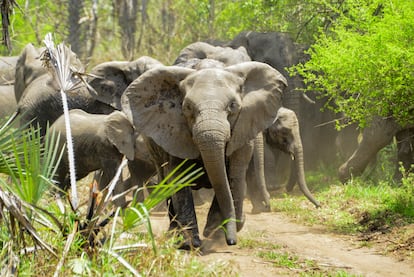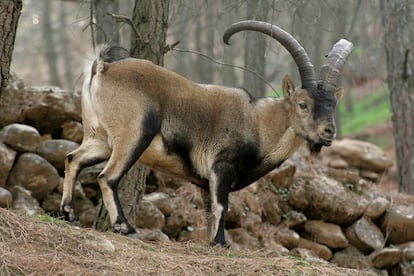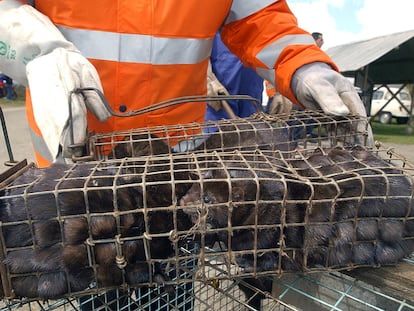Hunting is affecting the natural evolution of animals with horns or tusks
Many elephants are now born without the emblematic ivory and goat scurs are getting smaller

Hunting, whether legal or illegal, upsets the natural order because hunting animals with large horns or tusks create an artificial selective pressure that supplants natural selection. Animals that have thrived for millions of years are now more likely to die at the hands of humans before they can procreate and pass their genes on to the next generation. This has led to increased numbers of tuskless elephants or dominant male goats with smaller defensive horns. The ecological consequences of this trend have yet to be determined.
For animals, one of the most harmful forms of human disruption is trophy hunting, a practice that seeks out specific animal characteristics. Throughout the colonial era, Westerners traveled to Africa to hunt two of its most imposing animals – elephants and rhinos. As with deer and goats in northern climes, the larger the tusks or horn, the more valuable the animal. Whatever their motivations – ego, fame or self-indulgence – hunters always wanted to be photographed with the animals they killed. Hunters like Spain’s Emeritus King Juan Carlos on safari in Botswana, or former US president Theodore Roosevelt, a century earlier.
These photographs were used by a group of researchers to demonstrate how rhino horns have been steadily shrinking since the end of the 19th century. They analyzed 4,441 pictures from a database of rhinoceros images dating back to 1886, a third of which are photographs. Almost a hundred of the photos depict rhinos killed by humans, often showing their hunters standing beside their kills. The five extant species all demonstrated the same trend – rhinos photographed in the 1990s (there are no more recent images) have smaller tusks than those hunted 100 years earlier. Trophy hunting has been banned everywhere because it had pushed rhinos to the brink of extinction. In the early 20th century, three species of African rhinos had a total population of 500,000, while in Asia the populations were much smaller. By the 1980s, rhinos were down to a few thousand, and one species could be considered extinct. Conservationists warn that illegal poaching is still happening, so the decline will continue.
Oscar Wilson, a researcher who was with the University of Cambridge (UK) when he participated in the rhino study, says that the decreased size of rhinoceros horns will have ramifications. “We don’t know exactly what will happen, but rhinos use their horns to defend territory and attract mates, so we think it’s likely that smaller horn size will have an impact on their ability to do these things.” And there’s another frightening possibility. “We’re also concerned that it will cause poachers to shoot more rhinos to get the same volume of horn,” says Wilson, who is now with the University of Helsinki (Finland).

Because Wilson’s study used old photographs, the exact percentage reduction in horn size could not be calculated. But there are some very precise data for elephants. In late 2021, Science published one of the most extensive studies of the rapid evolution of tusklessness in African elephants. Now conservations had real data to back up their anecdotes about how more and more elephants are born without tusks. Like the various rhinoceros species and other large herbivores, elephants are extremely important to the entire ecosystem. Scientists call them ecosystem engineers due to their ability to modify the surrounding landscape. If more and more elephants are born without tusks, it will have ramifications for their ecosystem.
The study published in Science is based on almost 50 years of observation of an elephant population that has experienced intense hardship and is still threatened by poachers who want to remove their tusks. In the early 1970s, there were about 2,500 elephants in Gorongosa National Park in Mozambique. But when civil war broke out in 1977, the park became a war zone and both sides used poached ivory to finance their armies. When the war finally ended in 1992, only 200 elephants remained. But park rangers and researchers from Princeton University observed something else – before the war, only 18.5% of elephant calves were born without tusks. After the war, the ratio had leaped to 50.9%.
Tusks suddenly became a problem for elephants, but under natural circumstances, they are very useful tools”Brian Arnold, Princeton University
Princeton researcher Brian Arnold says: “Tusks suddenly became a problem for elephants, but under natural circumstances, they are very useful tools.” They have a defensive function but are also used for feeding, so elephants without tusks need different diets. “Specifically targeting females with tusks gave females without them a big competitive advantage,” Arnold adds.
The pervasiveness of the trend observed in Gorongosa National Park is unclear. Another recent study using data from parks in Zambia, Mozambique’s neighbor to the west, found that the proportion of elephants born without tusks rose from 10.5% in 1969 to 38.2% 30 years later. But according to George Wittemyer, a researcher at Colorado State University, there was no change in the proportion of tuskless calves in Kenyan reserves. Wittemyer has studied elephants and the threats they face in the Samburu and Buffalo Springs national reserves in northern Kenya for more than 20 years. “Asian elephants have been selected by humans to the point where the females no longer have tusks, and the species have survived,” says Wittemyer. But the ecological impacts are another matter. “While we can say they will survive without tusks, this could disrupt behavioral and ecological interactions.”
In the northern hemisphere, declining horn size has taken a toll on goats. One of the first to notice the trend was David Coltman, an ecologist at the University of Alberta in Canada. In 2003, he published a paper on a population of mouflon, an imposing horned mountain goat native to North America. Due to hunting, the males’ horns had shrunk by nearly 30% between 1973 and 1996, when hunting was banned because there were very few legal-sized rams left.
“Large horns are usually found on higher quality individuals, so we suspect that killing rams with larger horns can make a population less viable,” says Colman. Several papers have demonstrated that horn or antler size is associated with higher sperm quality and, in turn, better hereditary fitness. “We have also observed an association between larger antlers in females and greater reproductive success, so hunting could have additional indirect effects on females.”

The phenomenon has also been observed in other bovine species, such as chamois in the European Alps and Spain’s mountain goats. Jesús Pérez, an ecologist at the University of Jaén, has been studying the impact of trophy hunting on several species of mountain ungulates for two decades. In a paper published in 2011, Pérez observed that the average horn length of mountain goats in Sierras de Cazorla, Segura, and Las Villas Natural Park, Jaén, decreased by 15.4% between 1975 and 1985. Meanwhile, the antler size of the Atlas mouflon (a North African mountain goat species introduced into Spanish hunting grounds), decreased by 10.9% between 1980 and 1991. Both species reach maturity between the ages of eight and 10, which is when their horns reach full size. Another study by Pérez measured the horns of 2,815 mountain goats between 1995 and 2017 and observed the same decline in size.
Large horns are usually found on higher-quality individuals, so we suspect that killing rams with larger horns can make a population less viable”David Coltman, University of Alberta
“We rarely see the big old animals anymore in the Sierra Nevada,” says Pérez. “They are either very good at hiding or have already been killed by hunters. We have heard from many researchers that increasingly younger animals are being hunted.” But Pérez says there is no consensus among scientists about the long-term effects of hunting on horn size. “Some say there’s an evolutionary response, but others say evolution is slowing down.”
Understanding the impact of hunting is critical. Does it have a simple demographic effect of physically eliminating the animals with the largest tusks or horns? Or does it have the evolutionary impact of producing successive generations will smaller ones? Marco Festa-Bianchet, a biologist at the University of Sherbrooke in Canada, has long studied the impact of hunting on goats and cervids (deer). “As far as I know, there is no evidence [of evolutionary impacts] in deer. Obviously, there are some demographic effects – if all the big ones are eliminated, only the small ones remain. But there is no evidence, as far as I know, of an evolutionary effect.”
The latest study by David Coltman using data from the last 20 years shows that “horn size [in Canadian mouflon] stopped declining with the hunting ban and shows some signs of recovery.” Yet in 2020, 30 years after Mozambique’s civil war ended, one-third of the elephants in Gorongosa are born without tusks.
Sign up for our weekly newsletter to get more English-language news coverage from EL PAÍS USA Edition
Tu suscripción se está usando en otro dispositivo
¿Quieres añadir otro usuario a tu suscripción?
Si continúas leyendo en este dispositivo, no se podrá leer en el otro.
FlechaTu suscripción se está usando en otro dispositivo y solo puedes acceder a EL PAÍS desde un dispositivo a la vez.
Si quieres compartir tu cuenta, cambia tu suscripción a la modalidad Premium, así podrás añadir otro usuario. Cada uno accederá con su propia cuenta de email, lo que os permitirá personalizar vuestra experiencia en EL PAÍS.
¿Tienes una suscripción de empresa? Accede aquí para contratar más cuentas.
En el caso de no saber quién está usando tu cuenta, te recomendamos cambiar tu contraseña aquí.
Si decides continuar compartiendo tu cuenta, este mensaje se mostrará en tu dispositivo y en el de la otra persona que está usando tu cuenta de forma indefinida, afectando a tu experiencia de lectura. Puedes consultar aquí los términos y condiciones de la suscripción digital.
More information
Archived In
Últimas noticias
The complicated life of Francesca Albanese: A rising figure in Italy but barred from every bank by Trump’s sanctions
Half of Scotland is in the hands of 420 property owners
Pinochet’s victims grapple with José Antonio Kast’s rise in Chile
Reinhard Genzel, Nobel laureate in physics: ‘One-minute videos will never give you the truth’
Most viewed
- Pablo Escobar’s hippos: A serious environmental problem, 40 years on
- Why we lost the habit of sleeping in two segments and how that changed our sense of time
- Charles Dubouloz, mountaineering star, retires at 36 with a farewell tour inspired by Walter Bonatti
- Reinhard Genzel, Nobel laureate in physics: ‘One-minute videos will never give you the truth’
- The Florida Keys tourist paradise is besieged by immigration agents: ‘We’ve never seen anything like this’











































